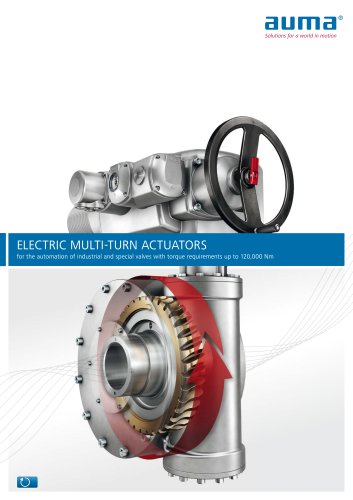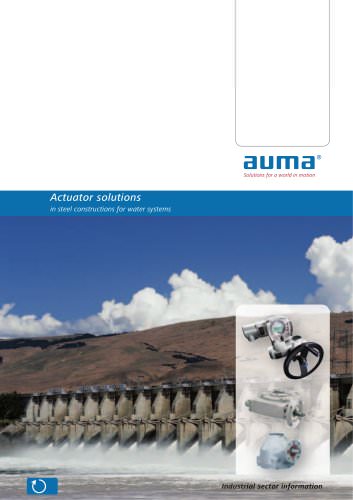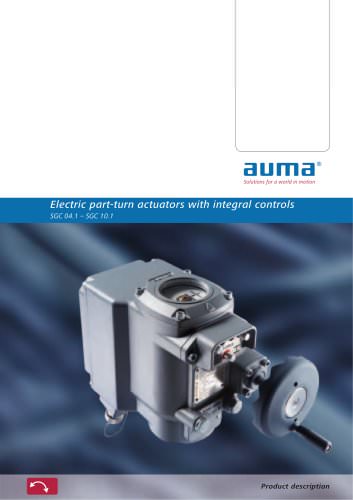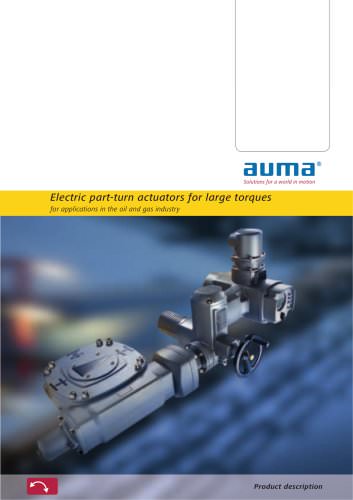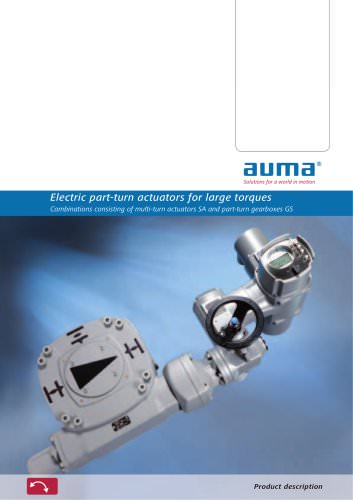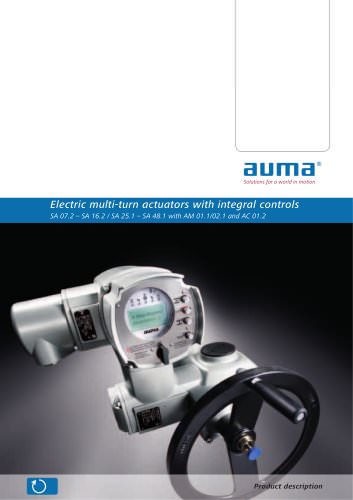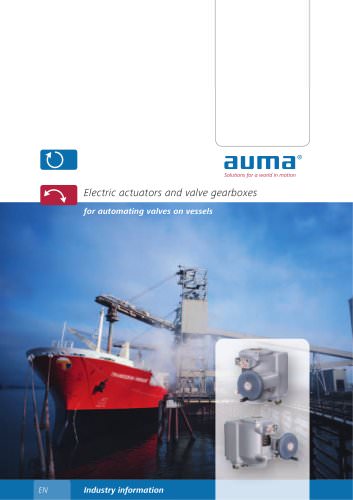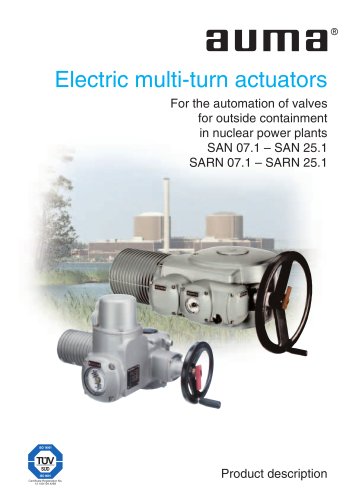 Website:
AUMA
Website:
AUMA
Group: AUMA
Catalog excerpts

Electric multi-turn actuators for the automation of valves for inside containment in nuclear power plants SAI 6 – SAI 100 SARI 6 – SARI 100 Certificate Registration No. 12 100/104 4269 Product description
Open the catalog to page 1
Electric actuators are among the most important components of the safety system of a nuclear power plant. This means that the actuators have to operate the valve correctly under defined conditions and to remain safely operable even under AUMA is one of the leading electric actuator manufacturers worldwide and has been manufacturing electric power plants for more than 25 years. Actuators from that time are still in use today which proves the opera- tional reliability of these devices. Apart from the multi-turn actuators (SA/SAR), AUMA has two multi-turn actuator ranges SAN/SARN and SAI/SARI...
Open the catalog to page 2
Applications AUMA multi-turn actuators of the type ranges SAI and SARI are qualified for the use inside containment and correspond to the 1E qualification according to IEEE 382. This corresponds to the violet section in the illustration. The actuators can be adapted to suit the requirements of nearly all valve applications. This is achieved by: Graded protection concept In a compact, solid and DBE resistant housing in enclosure protection IP 68, components are installed which are themselves qualified for DBE conditions. All outer housing components are made of aluminium free materials. The...
Open the catalog to page 3
Multi-turn actuators SAI 6 – SAI 100, SARI 6 – SARI 100 Multi-turn actuators SAI 6 – SAI 100 SARI 6 – SARI 100 ■ Torques from 20 to 1 000 Nm ■ Output speeds from 4 to 180 rpm with bevel gear for handwheel operation Definition for multi-turn actuators according to EN ISO 5210 A multi-turn actuator is an actuator which transmits to the valve a torque for at least one full revolution. It is capable of withstanding thrust. 4
Open the catalog to page 4
Summary of functions/equipment Equipment & functions ● Standard ■ Option Open-close duty Seating – Limit seating – Torque seating Overload protection against torque peaks Limit and torque switches – Tandem limit switches DUO limit switching (intermediate position switch)1) Mechanical position indicator1) Remote position transmitter 3-ph AC motor Bevel gear for handwheel operation Combinations with AUMA part-turn gearboxes Combinations with AUMA linear thrust units2) Manual operation Description SARI 6 - SARI 100 on page ● Modulating duty Hammer blow effect Interfaces SAI 6 - SAI 100 ● ● ● ●...
Open the catalog to page 5
Functions Type designation The actuator version is defined by the designation according to type code. SA I - ‘R’ for modulating version Qualified for inside containment Size, e.g. 6 (max. torque in daNm) Flange size e.g. F10 Applicable for all versions only if applicable to define a version Open-close duty Input Actuators for open-close duty The valves are operated relatively seldom, the time intervals can span between a few minutes up to several months. Type of duty for multi-turn actuators for open-close duty (SAI) AUMA multi-turn actuators SAI for open-close duty are rated for short-time...
Open the catalog to page 6
Functions Modulating duty The controlled variable in a modulating application is affected by many influences. A change of the reference input signal, pressure fluctuation in the pipeline and temperature variations influence the process in such a way that a frequent adjustment of the MOV is required. For sensitive modulating applications the starts may be in intervals of a few seconds. Input signal from process controller Actuator for modulating duty Positioner Feedback signal to process controller Valve position feedback Therefore high demands are placed on actuators for this duty....
Open the catalog to page 7
Functions Seating Depending on the design of the valve to be operated, end position switching either limit seating, i.e. by measuring the valve travel completed, or torque seating, i.e. after reaching a defined torque. For this purpose, the actuator is equipped with two independent measuring systems, i.e. limit switching and torque switching. The type of seating has to be taken in account both when setting the actuator and in the actuator control. However, the processing of signals for the two types of seating differs. Torque seating Limit seating Torque Speed Set tripping torque P Travel...
Open the catalog to page 8
Functions Overload protection against torque peaks The torque switching, used for torque seating in the end position (see page 8), serves as overload protection for the entire travel, even in the case of limit seating. After the controls have processed the torque switch signal accordingly, the motor will be switched off. As a result, valve and actuator are protected from damage. If excessive torque builds up in the valve in an intermediate position, e.g. due to a trapped object, the torque switching trips after reaching the set tripping torque. Torque peaks Depending on the actuator/valve...
Open the catalog to page 9
Equipment Limit and torque switches With the help of the switches, the mechanically measured travel (i.e. number of turns) and torque are converted into usable signals for the actuator controls. In the standard version, the actuators are equipped with four switches: ■ one limit switch each for the end positions OPEN and CLOSED, ■ one torque switch each for the directions OPEN and CLOSE. The limit switches are tripped when the set switching point, i.e. an end position, is reached and the torque switches are tripped when the set tripping torque is exceeded. Torque switches If the actuator is...
Open the catalog to page 10
Equipment DUO limit switching/intermediate position switches (option) With DUO limit switching an additional switching point can be set for each direction of rotation (intermediate position switches). The switching can be set to any valve position between the end positions. The switch will remain operated from set tripping point to end position if not more than 120 turns of the hollow output shaft are in between. The switch signal can be used for any purpose, e.g. to: ■ signal a certain valve position ■ to start an additional actuator which is mounted on a bypass valve ■ to start or switch...
Open the catalog to page 11All AUMA catalogs and technical brochures
-
ELECTRIC ACTUATORS
6 Pages
-
Multi-turn actuators
92 Pages
-
Electric multi-turn actuators
40 Pages
-
SAEx 07.2
1 Pages
-
FUNCTIONAL SAFETY – SIL
28 Pages
-
Service Worldwide
8 Pages
-
SIMA² Master Station
6 Pages
-
AUMA Cloud + AUMA Assistant App
14 Pages
-
AUMA Support App
4 Pages
-
electric actuators
56 Pages
-
FUNCTIONAL SAFETY SIL
28 Pages
-
Service world wide
12 Pages
-
Explosions proof actuators
24 Pages
-
The Actuator Specialist
32 Pages
Archived catalogs
-
Test bench PV 1405
24 Pages
-
Service device PV 788 B
4 Pages
-
Electric part-turn actuators
4 Pages
-
Electric multi-turn actuators
24 Pages
-
Multi-turn gearbox GHT 360.1
4 Pages
-
Master station SIMA
4 Pages











